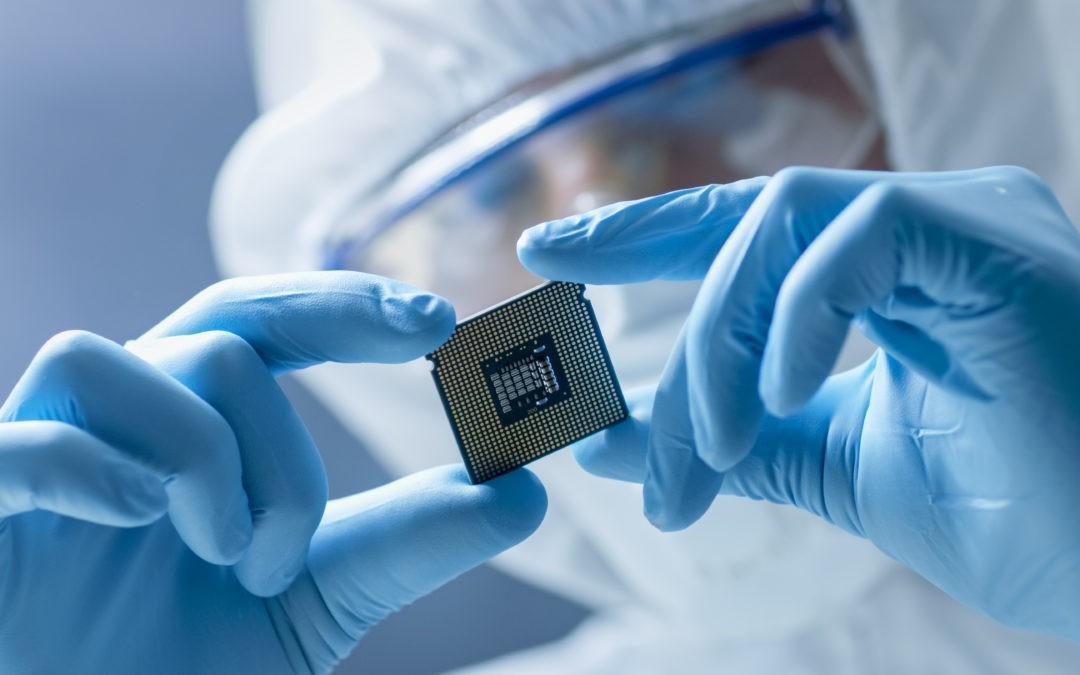Microelectronics manufacturing often involves delicate materials and occasionally toxic substances that require special care for handling and storage. Manufacturing equipment is also highly sensitive and generates heat which must be controlled.
For applications in microelectronics manufacturing to be successful, a high level of control is required over the manufacturing environment. A cleanroom allows regulation of environmental factors like temperature, relative humidity, air quality, static electricity, and more. They are often necessary for microelectronics manufacturing applications to ensure quality and consistency.
Lets look at 4 specific applications of microelectronics manufacturing and how a specialized cleanroom can help achieve their goals.
#1 Semiconductor Cleanrooms
Semiconductors are used to make nearly every piece of technology we rely on today — from cell phones to coffee machines to vehicles. To make the complex microchips these devices need to function and respond with the speed and accuracy modern life demands, they require semiconductors to be meticulously manufactured and assembled.
As the demand for technology continues to rise, semiconductor manufacturers must produce more without sacrificing quality. That’s where a semiconductor cleanroom proves its worth. A strictly controlled environment streamlines the manufacturing process and significantly reduces risk to safety and productivity by limiting particle count and size, temperature fluctuations, relative humidity, and other factors that commonly threaten semiconductor production.
#2 Silicon Wafer Manufacturing Cleanrooms
Silicon wafers are delicate but powerful products that are an essential part of semiconductor devices. Their ability to conduct electricity in a controlled manner makes them highly prized for fine electronics. Silicon used for semiconductors is grown first as an ingot with other elements called dopants, then precisely cut to form thin wafers which are used to produce microchips and other semiconductor applications.
The process of manufacturing silicon wafers requires extreme care. Particularly in the polishing stage of the process, where chemical slurries are used to remove any imperfections on the surface of the silicon wafer, protection from contaminating particles is critical. Polishing must typically be conducted within a cleanroom that meets the standards of ISO Class 5 at minimum to protect both products and personnel during this stage.
#3 SMT Assembly Cleanrooms
Surface-mount technology (SMT) assembly involves automated machinery which connects electronic components to printed circuit boards. These machines use a soldering paste to place and attach the components. SMT assembly must take place in a controlled environment to allow the equipment to work at an optimal level of efficiency.
An ISO Class 7 or 8 cleanroom is common for this microelectronics manufacturing application. A powerful cleanroom HVAC system regulates environmental factors to offset heat generated by machinery and fan filter units remove contaminants and deliver clean, filtered air into the space.
#4 Solar Technology Cleanrooms
Solar cells are used to make electronics that capture the sunlight and convert it into electricity. Before they can be used in a solar panel, they start as a thin slice of silicon and other conductors. Silicon wafers are used to develop solar cells through a complex process of texturing, etching, acid cleaning, and diffusion. Each step in the process requires strict control, as any interfering particles could compromise the product.
Cleanrooms are invaluable in the process of manufacturing solar cells — meeting ISO Class 5 – Class 7 standards. As the silicon wafer is refined, extra care must be taken to ensure that particles cannot damage the semiconductor or disrupt its delicate purposes. A cleanroom using HEPA and ULPA filters can help prevent product failures and secure success for solar cell projects.
Cleanroom Design for Microelectronics Manufacturing
Semiconductor cleanrooms and similar applications use carefully designed systems to regulate temperature and humidity. A robust filtration system limits particles which could interfere with equipment or compromise products. Other cleanroom systems like ESD-safe materials and fire suppression work to protect personnel in the space from the hazards of their work. All components of the cleanroom must also not contribute to the environment by shedding particles or outgassing and must be easy to clean completely.
When properly designed and built, cleanrooms offer a great value to semiconductor manufacturing and other applications involving microelectronics. If you need a cleanroom capable of keeping up with you and your microelectronics manufacturing goals, let us know. We’re happy to design, manufacture, and install the cleanroom that fits your classification and your application.


